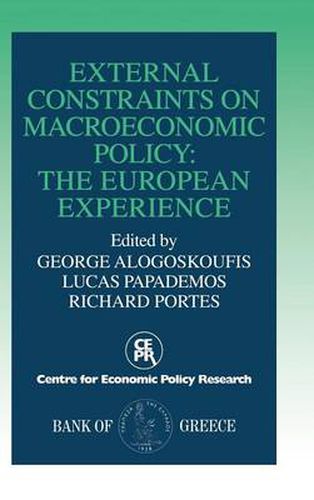Readings Newsletter
Become a Readings Member to make your shopping experience even easier.
Sign in or sign up for free!
You’re not far away from qualifying for FREE standard shipping within Australia
You’ve qualified for FREE standard shipping within Australia
The cart is loading…






This book from the Centre for Economic Policy Research deals with the implications of the exchange rate regimes and capital flows of the 1990s for government macroeconomic policy-making and EC policy coordination. It has long been recognized that openness is a mixed blessing for many European economies. While it offers the opportunity of international and intertemporal trade, it also imposes additional constraits on the design of stabilization policies. The exact nature of these constraints is not always clear, and there remains much uncertainty abour their quantitative importance and their dependence on the exchange rate regime. under the fixed exchange rates of the 1950s, economists and policy-makers had a much clearer idea of the nature of the external constraints. The current situation is markedly different and changing rapidly. The commitment to defending the exchange rate is stronger in the 1990s than in the 1970s and 1980s, but at the same time international capital flows are now far greater and freer than in the 1950s and 1960s, with many countries able to borrow almost indefinitely and on good terms on the Eurodollar market in order to finance their balance-of-payments deficits. This volume, derived from a conference organized jointly by CEPR and the Bank of Greece, deals with these issues in depth and includes both cross-country comparisons and case studies of individual countries.
$9.00 standard shipping within Australia
FREE standard shipping within Australia for orders over $100.00
Express & International shipping calculated at checkout
This book from the Centre for Economic Policy Research deals with the implications of the exchange rate regimes and capital flows of the 1990s for government macroeconomic policy-making and EC policy coordination. It has long been recognized that openness is a mixed blessing for many European economies. While it offers the opportunity of international and intertemporal trade, it also imposes additional constraits on the design of stabilization policies. The exact nature of these constraints is not always clear, and there remains much uncertainty abour their quantitative importance and their dependence on the exchange rate regime. under the fixed exchange rates of the 1950s, economists and policy-makers had a much clearer idea of the nature of the external constraints. The current situation is markedly different and changing rapidly. The commitment to defending the exchange rate is stronger in the 1990s than in the 1970s and 1980s, but at the same time international capital flows are now far greater and freer than in the 1950s and 1960s, with many countries able to borrow almost indefinitely and on good terms on the Eurodollar market in order to finance their balance-of-payments deficits. This volume, derived from a conference organized jointly by CEPR and the Bank of Greece, deals with these issues in depth and includes both cross-country comparisons and case studies of individual countries.